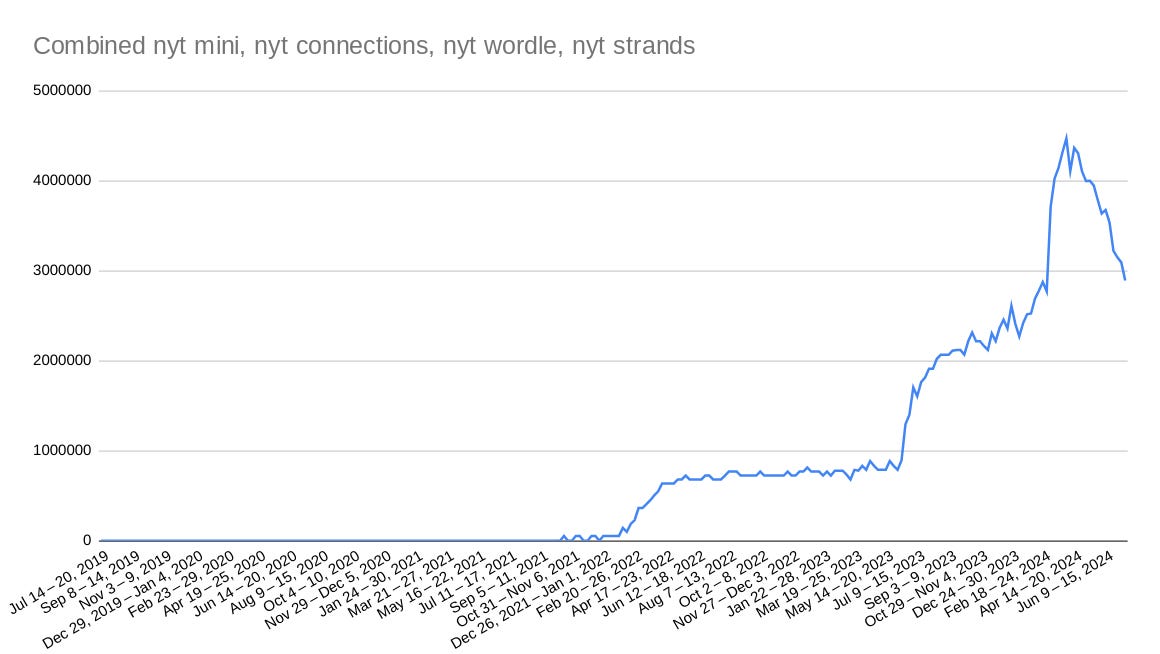The New York Times Is Not In the Business You Think It Is
Google Trends provides yet another indicator the news portion is a side hustle
When people think of Google searches they often think of informational searches — someone looking to find out how to unclog a drain, or figuring out which actors on The Wire are actually British. But a large number of Google searches are navigational. In navigational searches you put in a search term to get a link to a specific site you want to go to. For instance, you want to get to Facebook, you type facebook into a search bar, and the top link is to Facebook and you click that.
Despite some early attempts to get us all to make personal link portals early in the history of the web (remember delicious?), navigational searches are second only to location bar autocompletes as a means to get to where we want to go on the web. One side effect of that is that you can see certain patterns of web traffic through examining navigational search term usage. These search volumes aren’t perfect proxies for traffic, but can be suggestive.
For instance, we might look at people navigating to Facebook, and then increasingly not navigating to Facebook (though a lot of this is likely people getting on the app vs. the web):

Or look at the seasonal use of Zillow (the peaks are June-ish):

There’s one chart of a navigational term that I find jaw-dropping though. And that’s the chart for the term nyt which will get you to the New York Times. Here’s the trend from 2004 on for that navigational term. And it’s really odd. In a time when a lot of traffic is disappearing into apps — or just disappearing altogether — the navigational searches using this term rocket up in January 2022.

For a sense of scale, this little peak?
That’s November 2020, during the biggest election of this century.
So what’s the rest? If that’s the election, then what are the other runups? Here’s their dates:
From about December 2021 to April 2022
From June 2023 to Aug 2023
From February 2024 to April 2024
And what is that steep decline starting in May of this year?
Go ahead, create your theories. I’ll wait.
Done?
To show what is driving navigational searches, we can identify and overlay subqueries. Again, the queries here are just one indicator of interest, not traffic volumes. But to the extent the subqueries are substantial and follow the shape of the increase, they can be seen as driving much of the pattern, and indicative of shifts in user behavior. So let’s start with subquery one, explaining that December 2021 to April 2022 increase.
Ready?

It’s Wordle.
What about that next segment, the dramatic climb? There’s a couple things going on here, but the major one? The NYT game Connections:
And that final climb? It’s the new NYT game Strands:
That dip at the end mostly comes down to a reduction in the amount of people navigating to either Strands or Connections. If you were to ask me (and I know, you didn’t) I’d say Strands is probably a bit of the novelty wearing off, and Connections might be about some increasing ridiculousness over the past couple months. Or maybe that’s me grousing.
When you put all of these searches together and add the nyt mini in you get an explanation for most of the rise and the dip. (We could also add in spelling bee, but maybe later).

On one level, it’s a cautionary tale about reading Trends. But on another, it’s a fascinating insight to traffic at the New York Times. Navigational search term volume is not a perfect proxy for traffic — in particular, we are discounting the people that end up visiting the site through links to articles they find online. There’s other navigational searches of course — nytimes, new york times — and the story looks a bit different with them in there, but not by much. NYT branding and autosuggest in Google has played a role here as well in focusing navigational searches for games around the the nyt term. And as a commenter points out, traffic in the two NYT apps — the news one and the games one — is invisible in this process and might have its own story to tell.
But stack up as many caveats as you like — I still think it’s a stunning pattern. To me, the navigational search pattern is just one of many indications of what Zack Zwiezen argued on Kokatu a few months ago using engagement data: the New York Times is increasingly a games site with a news business on the side.




>Navigational search term volume is not a perfect proxy for traffic — in particular, we are discounting the people that end up visiting the site through links to articles they find online.
I mean, you’re also discounting app traffic, which would presumably be substantial for a subscription-based news app. Right?
But it wouldn’t be terribly surprising if a non news feature drove a lot of traffic (and especially subscribers); the games are just the comics and classifieds of today.
So it's like the newspaper you got for the color comic supplement because the kids liked it.